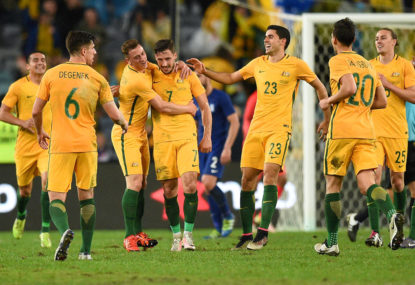LISTEN: 'You lost the league!' Everton fans troll Liverpool after denting Reds' title hopes
Everton won the Merseyside derby 2-0, with Toffees supporters taunting Liverpool after the game at their home ground Goodison Park.

While the Socceroos are heading for their fourth consecutive World Cup, we will fail to qualify for the 2022 tournament if we do not make drastic changes to the A-League.
Of the 23 players who made up the 2006 World Cup squad, 14 were playing regular football before the age of 18.
How many players under 18 have not even been given the chance to prove themselves on our only professional stage?
Look at the Matildas by comparison. The toast of the nation, they are ranked sixth in the world, are bidding to host the 2023 FIFA Women’s World Cup, and had five-figure attendances in Newcastle, Melbourne and Geelong.
Two of their rising superstars, Sam Kerr and Alanna Kennedy, both made their debuts in the W-League at the age of 15.
The FFA and the A-League clubs need to get serious about player development and production, and the best way to do this is to give cash incentives to clubs to dip into our biggest pool of talent, the NPL.
Clubs need an incentive to play youth players because right now they are more than happy to delve into their resources rather than produce players.
For this to occur, we need an expanded A-League, increased salary cap, and larger club squads. We also need to rethink our current system.
[latest_videos_strip category=”football” name=”Football”]
Youth NPL concession
This would see a player under the age of 20, who has played at least 17 matches – roughly three quarters of a season – in the previous NPL season, has 30 per cent of their wage annulled in the salary cap.
There are only three players who have been signed straight from NPL clubs into A-League squads this season and the numbers aren’t growing. This is farcical considering the vast majority of semi-pro footballers playing in the country are in the NPL system.
This rule breaks the barrier of the A-League’s relationship with the NPL, giving an incentive to sign young players,
Scholarship concession
Under the scholarship rule, each club can contract up to six under-20 Australian players on the national minimum wage. Any payments above the minimum wage are included in the salary cap.
This means if one of these young players makes at least 17 appearances in an A-League season, a percentage of their contract doesn’t count towards next season’s salary cap.
For example, Perth midfielder Brandon Wilson would have fallen under the youth A-League concession rule, as he played more than two-thirds of the last A-League season. So only 70 per cent of his salary would have counted towards the cap for the 2017-18 A-League campaign.
U20 matchday rule
This left-field rule would see that in an A-League matchday squad, a certain number of players under the age of 20 would have to be present – whether that is on the field or on the bench – and the number can vary.
With extended squads and five substitutions, at least two players is enough for this rule to yield benefits.
Along with the concession rules, if clubs aren’t incentivised to use young players, then maybe the FFA has to force their hand.
Raising youth roster numbers
At present, rosters must have a minimum of three Australian players aged 20 or under and clubs are averaging four in their squads of 23.
But why not a minimum of five, six or even seven? The amount of youngsters getting game time is drastically low, so perhaps utilising the cash concessions on youngsters may mean more minutes on the park.
These are just some of the rules that can be implemented to pull the A-League out of its youth development lurch.
By the end of the decade, we will hopefully have expanded to 12 teams, with a second-division format ready for more opportunities for youngsters.
Hopefully.